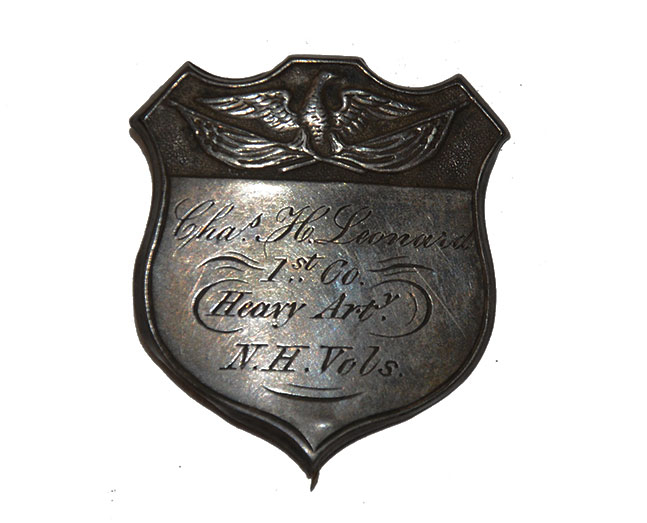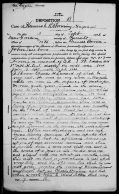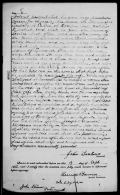site search
online catalog
CIVIL WAR SILVER IDENTIFICATION SHIELD OF (ALIAS) CHARLES H. LEONARD, NEW HAMPSHIRE HEAVY ARTILLERY: SAILOR, SOLDIER, SCOUNDREL

$1,650.00 SOLD
Quantity Available: None
Item Code: 172-6077
This attractive badge is stamped in the form of a shield with the upper section recessed and bearing an eagle in relief with spread wings, clutching two U.S. flags on a stippled ground, with the soldier’s name and unit engraved in script and block letters below: “Chas. H. Leonard / 1st Co. / Heavy Arty. / N.H. Vols.” This company was known under two different designations, which is rather appropriate given the owner of the badge.
While investigating the pension application of Mrs. Charles. H. Browning after her husband’s death in 1901, government clerks established that was just one of several names used by the late soldier and sailor, and that she was just one of several wives. They were able to catalog three names he used officially at different times, including his original name, Charles H. Loring, and three wives, though their interest was only in official documents and military service, and they missed at least one other name and, we think, at least one other wife. Needless to say, the two issues were related and he was dodging problems both martial and marital. About the only thing he did not shed along the way, aside perhaps from his fondness for liquor, was a good number of tatoos, likely accumulated during he service aboard ship at least as early as 1850, when the census of for Newton, MA, lists him in his parents’ household with three siblings and as age 19, but “at sea,” a service that included several stints in the US Navy from 1856 into the 1870s.
He seems, however, to have tried to use pseudonyms retaining his first name and middle initial, likely to avoid slip-ups in casual conversation. Testimony by two former fellow members of the 1st Company Mass Heavy Artillery was explicit that they knew him as Charles H. Leonard though, ironically, he shows up in official rosters of the company as “Albert H. Leonard.” He explained to comrades there had simply been a mix-up in names by the recruiting agent who had enrolled him and that he simply decided to go with it. The change of first name may have been a clerical error, but the change in last name was not. He had previously enlisted under his own name, Charles Loring, in Co. B of the 1st Battalion of Massachusetts Heavy Artillery, mustering in at Lowell, Mass. on Oct. 10, 1862, listing himself as 29 years-old, a seaman, and resident of Lowell, but had served for all of ten days before deserting on Oct. 20.
That service had followed at least two stints in the US Navy, the most recent being a year’s service as an ordinary seaman from Aug. 20, 1861, to Aug. 19, 1862. He had also married a Hannah Douglas of Chelsea, Maine, soon after his discharge. His enlistment in the Mass Heavy Artillery thus seems to have been to escape that. Whether he returned to her after escaping the army is unclear, but she was pregnant by that time, and died from complications of childbirth in May 1863 at her family’s home in Maine. The fate of the child is unclear. By one account he later returned and took the child with him to New Hampshire.
By June he was again looking for new opportunities and enlisted June 8, 1863 as Albert H. Leonard, mustering in as a corporal on July 2, 1863. He was remembered as a heavy drinker and was reduced to the ranks Feb. 1, 1865, for related issues, but remained in the company until muster out Sept. 11, 1865. The company had been organized in New Hampshire beginning in April 1863 by Capt. Charles Long, the disappointed Lieutenant Colonel of the 17th New Hampshire, which had failed to reach regimental strength. They mustered into service from May 26 to July, 22, 1863, at Concord and Portsmouth and were assigned to the defenses of Portsmouth, NH, and to the garrison of Fort Constitution at New Castle.
This provided another matrimonial opportunity, for he married once more on, on August 4, 1863, to a Jennie Wheeler of New Castle, listing his name on the marriage license as Charles H. Leonard and his occupation as “soldier.” He listed himself as 28 and widowed. She was 18. The posting at Portsmouth, must have seemed satisfactory enough, then, but the company was ordered to the defenses of Washington on May 6, 1864.
A second company, organized shortly after the first was sent to Washington at the same time. Both companies sent details to various forts, with men of the 1st Company sent to Forts Slocum, Stevens, Totten, Sumner and Batteries Cameron, Parrott, Kendall and Vermont. They saw some action in standing off Early’s raid on Washington in July 1864, and served in the Washington defenses until they were ordered back to Fort Constitution on November 25, 1864. While they were in Washington, however, recruiting for a regiment of New Hampshire heavy artillery had been successful and the two companies in Washington were made part of that unit, the 1st NH Heavy Artillery, with the 1st Company then redesignated as Company A about September 1864, though only seven companies of the regiment seem to have ever served together at one time. After returning to the state, the company continued to serve at Fort Constitution until mustered out September 11, 1865.
An army comrade testified his wife was with him for a time while the company was stationed in Washington. Since the company returned to New Castle before mustering out the couple may have been together until that time. Of course, this did not last. He enlisted once again in the Navy, for two-year’s service as a seaman on Dec. 27, 1865, at Portsmouth, NH, at that point claiming to be a resident of Lowell, Mass, age 31 with 9 years of naval service, born in Lowell, and a painter by occupation. The same comrade testified his wife later received a letter purportedly from a ship’s captain that he had died in New Orleans of Yellow Fever. This fits with latter testimony from her that he had abandoned her about 1867.
This may account for his last change of name, this time to “Charles H. Browning,” when he was working as a ship’s painter at Charlestown, Mass, and met and married Hannah Billado in Boston in 1870. She seems to have had more clinging power and stayed with him until his death in 1901. He seems to have briefly reappeared in the life of his previous wife to be divorced in 1876, there may have been a child involved, but Mrs. Browning did not know his real name until the 1890s when he had to come clean to some degree when applying for pensions and a couple of brief stays in veterans’ hospital.
Space prohibits too much more detail about Mr. Loring. The Navy Survivor’s Certificate file of “Mrs. Browning” is voluminous. We will add, though, that he seems to have been born in Massachusetts about 1831 and his father was an instrument maker judging by the 1850 census. We also note that government investigators, being interested only in his military service and his widow’s entitlement to a pension, may have missed at least one pre-war matrimonial fling. We find a Charles Loring marrying an Aurelia Lawrence in June 1851 in Boston, listing his age as 20 and his occupation as “Seaman.” Mr. “Charles H. Leonard” seems an obvious candidate as the groom. Like the ill-fated Mrs. Hannah Loring, she was from Maine, perhaps giving an idea of where his voyages took him. [sr][ph:L]
~~~~~~~~~~~~~~~~~~~~~~~~~~~~~~~~~~~
THIS ITEM, AS WITH ALL OTHER ITEMS AVAILABLE ON OUR WEB SITE,
MAY BE PURCHASED THROUGH OUR LAYAWAY PROGRAM.
CLICK HERE FOR OUR POLICIES AND TERMS.
THANK YOU!
Inquire About CIVIL WAR SILVER IDENTIFICATION SHIELD OF (ALIAS) CHARLES H. LEONARD, NEW HAMPSHIRE HEAVY ARTILLERY: SAILOR, SOLDIER, SCOUNDREL
For inquiries, please email us at [email protected]
Most Popular
Historical Firearms Stolen From The National Civil War Museum In Harrisburg, Pa »
Theft From Gravesite Of Gen. John Reynolds »
Selection Of Unframed Prints By Don Troiani »
Fine Condition Brass Infantry Bugle Insignia »
British Imported, Confederate Used Bayonet »
Piece Of Wood From The Room In The White House Where Lincoln Signed The Emancipation Proclamation »
featured item
FEDERAL MODEL 1860 LIGHT CAVALRY SABER FOUND ON EAST CAVALRY FIELD, GETTYSBURG – GEISELMAN COLLECTION
This Civil War artifact is Federal Model 1860 light cavalry saber that was recovered in the battle area at East Cavalry Field in Gettysburg. Once part of the Norbert Oyler Collection, this edged weapon specimen and its metal scabbard are fine… (942-14). Learn More »







